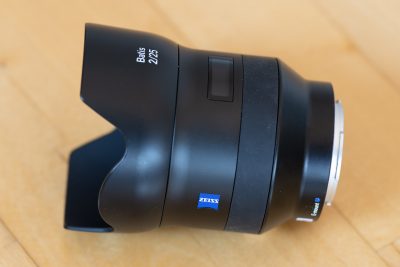Zeiss 25mm Batis f2 review
-
-
Written by Thomas
Quality
Testing: Longitudinal Chromatic Aberration and focus shift
Lenses with focal ratios of f2.8 or larger are often prone to longitudinal color aberrations (loCA, a.k.a. “axial color” or “Bokeh CA”). These show up as magenta coloration in the foreground and greenish hues in the background and are not easily corrected in post-processing. The Zeiss 25mm f2.0 Batis has relatively little loCA wide open especially in the background. At f2.8 it already looks very good. The following 100% crops show the foreground on the left and the background on the right with the first crop at f2.0, second at f2.8, third at f4.0:
Longitudinal Chromatic Aberration (loCA)
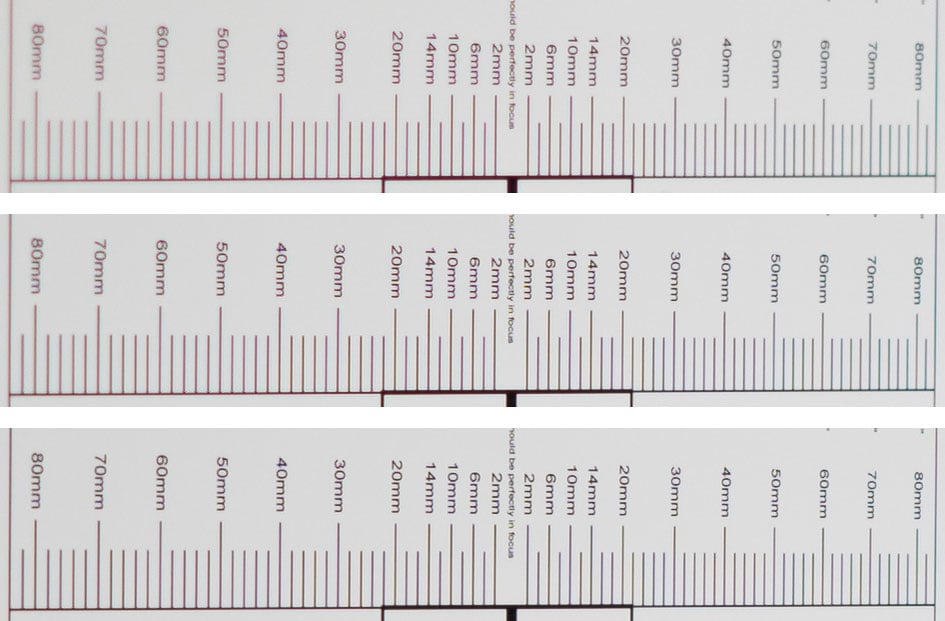
Above: Zeiss 25mm f2.0 Batis at f2.0, f2.8, f4.0; 100% crops
See an example of this effect in a real-life shot:

Above: Zeiss 25mm f2.0 Batis at f2.0; 100% crop; click image to access 4k version, click here for large original at Flickr
The test also revealed that there is no focus shift to worry about.
The Sony 24mm f1.4 GM has a little more aggressive greens (see here, crops are f1.4, 2.0, f2.8) similar to the Sigma 24mm f1.4 Art (here), while the Zeiss 28mm f1.4 Otus is somewhere in between (see here).
Sharpness and contrast
Let’s have a look at the theoretical performance of the Zeiss 25mm f2.0 Batis first and compare it to the alternatives from Sigma and Sony as well as its bigger sibling, the Zeiss Otus:
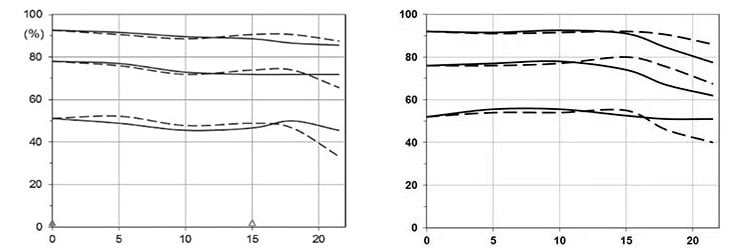
Abovet: MTF Zeiss 25mm f2.0 Batis (left), Zeiss 28mm f1.4 Otus (right)
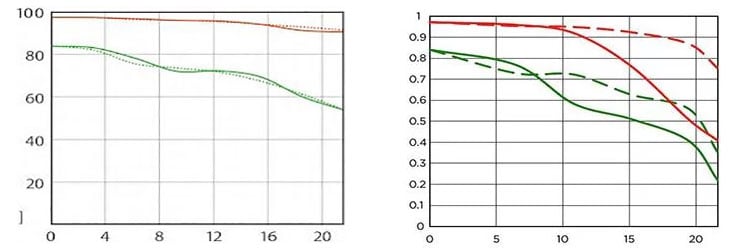
Above: MTF Sony FE 24mm f1.4 GM (left), Sigma 24mm f1.4 Art (right)
The MTF charts of the Zeiss lenses show the measured contrast wide open at 10, 20 and 40 lp/mm. This includes the influence of diffraction. The computed MTF charts from Sony and Sigma show contrast at 10 line-pairs per mm and 30 lp/mm at f1.4 without influence of diffraction. Higher values are better (more contrast) and the closer the line-pairs are together the less astigmatism (= resolution depends on the orientation of the test-pattern) the lens has. The x-axis displays the distance from the optical axis (=center of the sensor) in mm. I’ll show you the real-life performance at 4 mm (center), 13 mm (APS-C-corner), and 20 mm (FF-corner) on a 42MP Sony A7R II body.
From the charts the Zeiss 25mm f2.0 Batis looks similar to the Zeiss Otus and the Sony GM (with even less roll-off towards the corners) and clearly better than the Sigma Art. But if you compare the Batis with the other lenses keep in mind that the Batis is shown here at f2.0 and the others at f1.4. So it’s more revealing to look into real life results in the sharpness test based on Siemens-stars. Processing was done in Lightroom 8/CRAW 11 from RAW to Adobe Color profile with the built-in lens profile applied except for distortion control. Noise-reduction is set to 0, sharpening to 50/0.5/36/10, with no extra tone, color, or saturation adjustment. White-balance was adjusted to a neutral white and I did some exposure compensation to make the brightness of all crops match. So you will not see light fall-off in the corners. Removal of lateral color aberrations is ON, longitudinal CA are not corrected.
The following 100% crops show the Zeiss 25mm f2.0 Batis at f2.0 compared to the Sony 24mm f1.4 GM, the Sigma 24mm f1.4 Art, and the Zeiss 28mm f1.4 Otus. The Zeiss Otus / Sigma Art were shot on a 45MP Nikon Z7 / 36MP Nikon D810 respectively. The linear resolution of the Z7 sensor is only 4% higher than from the Sony A7R II and of the D810 sensor 7% lower which should not make a visible difference in this comparison.
Zeiss 25mm f2.0 Batis; 100% crop from center, APS-C/DX-corner, FF/FX-corner

Above: Zeiss 25mm f2.0 Batis at f2.0

Above: Sony FE 24mm f1.4 GM at f2.0; also available at f1.4, f1.6, f1.7, f2.8, f4.0, f5.6, f8.0, f11

Above: Sigma 24mm f1.4 Art on a 36MP Nikon D810 at f2.0; also available at f1.4, f2.8, f4.0, f5.6, f8.0, f11

Above: Zeiss 28mm f1.4 Otus on a 45MP Nikon Z7 at f2.0; also available at f1.4, f1.6, f1.8, f2.8, f4.0, f5.6, f8.0, f11
In this comparison the Zeiss Batis is is a little less sharp in the center than the Sony GM and Zeiss Otus but is better in the APS-C and FF corner than the Sony GM. The Sigma Art suffers from soft corners and the Zeiss Otus combines both a very sharp center and very good corners.
Now let’s see how the Zeiss 25mm f2.0 Batis develops when stopped down further:

Above: Zeiss 25mm f2.0 Batis at f2.8

Above: Zeiss 25mm f2.0 Batis at f4.0

Above: Zeiss 25mm f2.0 Batis at f5.6

Above: Zeiss 25mm f2.0 Batis at f8.0

Above: Zeiss 25mm f2.0 Batis at f11
Stopping the Zeiss 25mm f2.0 Batis further down helps the lens only slightly as it is already very good wide open. At f4.0 the FF-corner become very sharp. This test also revealed that the lens has only very little field curvature at this distance. All-in-all a very good result.
Performance at long distances
The Siemens-star test-targets are shot at a distance of 45x focal length (i.e. at around 1m). But performance of lenses also depends on the shooting distance. Therefore I present another series of test-shots of a city around 1 km away. Processing was done in Lightroom 8/CRAW 11 from RAW to Adobe Color profile with the lens-profile automatically applied – as far as Adobe’s RAW converter recognizes it (i.e. no distortion control). Noise-reduction is set to 0, sharpening to 50/0.5/36/10, with no extra tone, color, or saturation adjustment. I used autofocus at the largest aperture and did not change focus for other apertures. All shots were made at ISO 100 and image stabilization switched off.
The main image shows the complete scene wide open to give you an impression of the angle of view and to judge vignetting. You can access the respective shots up to f11 via the links beneath the main image. Following the main image are 100% crops from the Zeiss 25mm f2.0 Batis compared to the Sony FE 24mm f1.4 GM, the Sigma 24mm f1.4 Art and Zeiss 28mm f1.4 Otus at f2.0. The Zeiss Batis and the Sony GM were shot on the same day only minutes apart while the Zeiss Otus / Sigma Art were shot another day on a 46MP Nikon Z7 resp. Nikon D810. The small differences in linear resolution compared to the Sony A7R II should not make a visible difference but atmospheric conditions certainly do.
You can click on each image to access the large original. Please respect our copyright and only use those images for personal use.
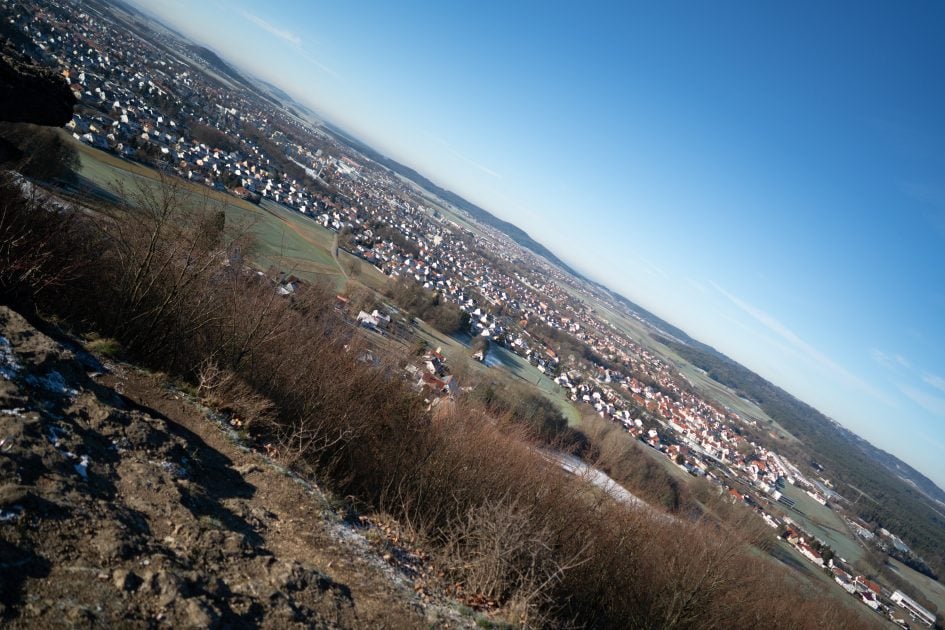
Above: Zeiss 25mm f2.0 Batis at f2.0; click image for 4k version; available as large original at f2.0, f2.8, f4.0, f5.6, f8.0, f11

Above: Zeiss 25mm f2.0 Batis at f2.0; 100% crop from center, APS-C-corner, FF-corner

Above: Sony FE 24mm f1.4 GM at f2.0; 100% crop from center, APS-C-corner, FF-corner; available as large original at f1.4, f1.6, f1.7, f2.0, f2.8, f4.0, f5.6, f8.0, f11

Above: Sigma 24mm f1.4 Art on a 36MP Nikon D810 at f2.0; 100% crop from center, APS-C-corner, FF-corner; available as large original at f1.4, f2.0, f2.8, f4.0, f5.6, f8.0, f11

Above: Zeiss 28mm f1.4 Otus on a 45MP Nikon Z7 at f2.0; 100% crop from center, APS-C-corner, FF-corner; available as large original at f1.4, f1.6, f1.8, f2.0, f2.8, f4.0, f5.6, f8.0, f11
The Sony GM has a clear lead over the Zeiss Batis in the center and is a little sharper in the APS-C-corner too. In the FF-corner both lenses look very similar. The Sigma Art is also very sharp in the center at f2.0 but is clearly lagging behind the other lenses in the corners.
Following is how the Zeiss 25mm f2.0 Batis develops when stopped down:

Above: Zeiss 25mm f2.0 Batis at f2.8; 100% crop from center, APS-C-corner, FF-corner

Above: Zeiss 25mm f2.0 Batis at f4.0; 100% crop from center, APS-C-corner, FF-corner

Above: Zeiss 25mm f2.0 Batis at f5.6; 100% crop from center, APS-C-corner, FF-corner

Above: Zeiss 25mm f2.0 Batis at f8.0; 100% crop from center, APS-C-corner, FF-corner

Above: Zeiss 25mm f2.0 Batis at f11; 100% crop from center, APS-C-corner, FF-corner
Both the APS-C- and the FF-corner profit from stopping down to f5.6.and become very sharp by then.
Vignetting
To make it easier to see light fall-off in the corners of a full-frame sensor I’ve arranged a series of shots with the Zeiss 25mm f2.0 Batis, the Sony FE 24mm f1.4 GM, and the Sigma 24mm f1.4 Art at different apertures. All images were developed to the same brightness in the center and the integrated lens profile applied to the Sony and the Zeiss lens, Shading Compensation in camera was set to Auto. The Sigma was shot on a Nikon D810 with no lens profiles applied in post-processing.
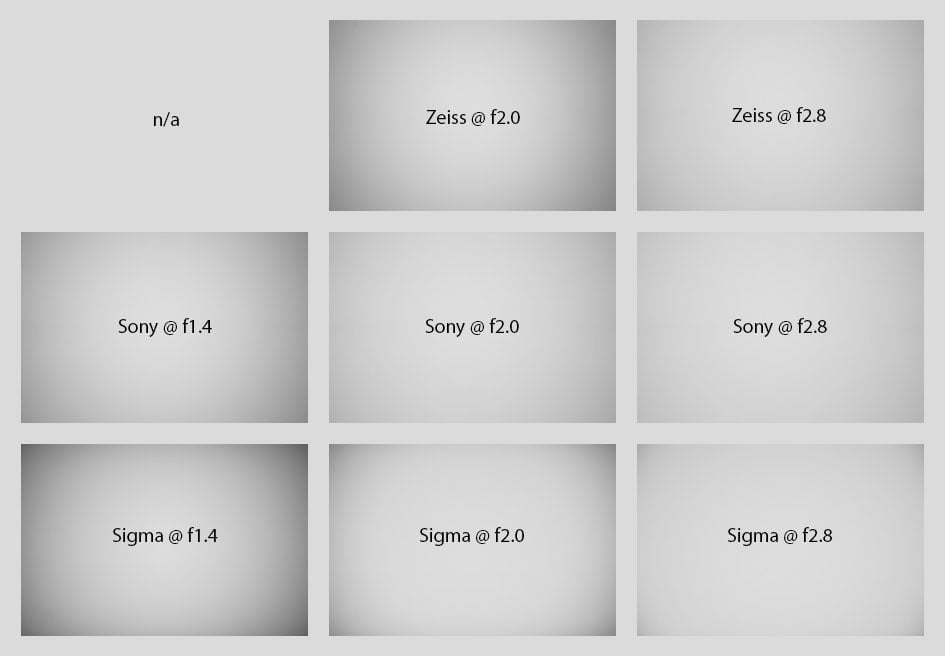
Above: Zeiss 25mm f2.0 Batis vs. Sony FE 24mm f1.4 GM vs. Sigma 24mm f1.4 Art at f1.4, f2.0, f2.8
The sample images above show that even with the lens profiles applied vignetting of the Sony 24mm f1.4 GM and the Zeiss Batis are very visible wide open. With no lens profiles applied the Sigma Art looks much worse at f1.4. At f2.0 the Sony GM looks best followed by the Sigma Art and the Zeiss Batis. At f2.8 the Zeiss Batis still has the strongest vignetting of the three but I would not worry about it.
Rendering of point-light sources at night-shots
Night-shots pose a different challenge for lenses as the contrast is even higher than under bright sun and point-light sources can reveal some weaknesses such as coma, haloing and color-aberrations that do not show up as prominently in other test-shots. The 100% crops below the main image show the effect of coma in the FF-corner of the Zeiss 25mm f2.0 Batis, Sony GM, Sigma Art and Zeiss Otus at various apertures:
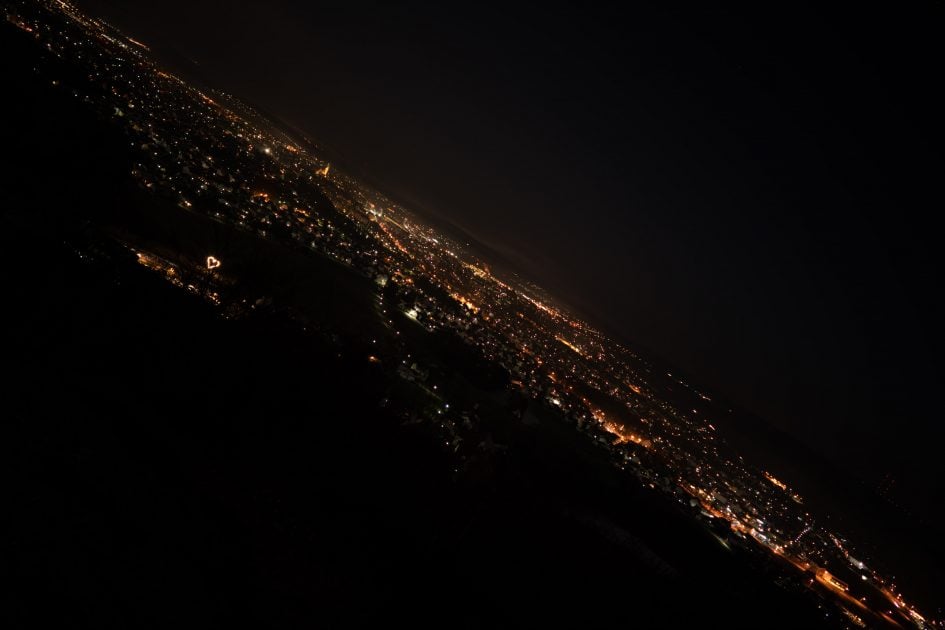
Above: Zeiss 25mm f2.0 Batis at f2.0; click image for 4k version, available as large original at f2.0, f2.8, f4.0, f5.6, f8.0

Above: Zeiss 25mm f2.0 Batis; 100% crops from the FF-corner at f2.0 (middle), f2.8 (right)

Above: Sony FE 24mm f1.4 GM; 100% crops from the FF-corner at f1.4 (left), f2.0 (middle), f2.8 (right)

Above: Sigma 24mm f1.4 Art on a 36MP Nikon D810; 100% crops from the FF-corner at f1.4 (left), f2.0 (middle), f2.8 (right)

Above: Zeiss 28mm f1.4 Otus on a 45MP Nikon Z7; 100% crops from the FF-corner at f1.4 (left), f2.0 (middle), f2.8 (right)
The Zeiss Batis has very low coma bested only by the Sony GM. The Sigma Art is clearly the worst of the four lenses. The only deficiency I can find with the Zeiss Batis is that it (like the Sony GM) shows some magenta haloing around bright lights at f2.0:

Above: Zeiss 25mm f2.0 Batis at f2.0; 100% crop
The effect is gone at f2.8.
Rendering of out-of-focus point-light sources
This test is for the rendering of point-light sources in an out-of-focus background. The circle of confusion that is produced by this test is pretty indicative of Bokeh performance (in the background) and light fall-off. Ideally the out-of-focus image of the point-light is evenly lit and perfectly circular, with no “onion-rings”, and without coloration. Large aperture lenses normally produce an effect known as “cat’s eye” the further away from the optical axis the point-light is projected. This is due to optical vignetting in the lens barrel when light enters the lens from an angle.
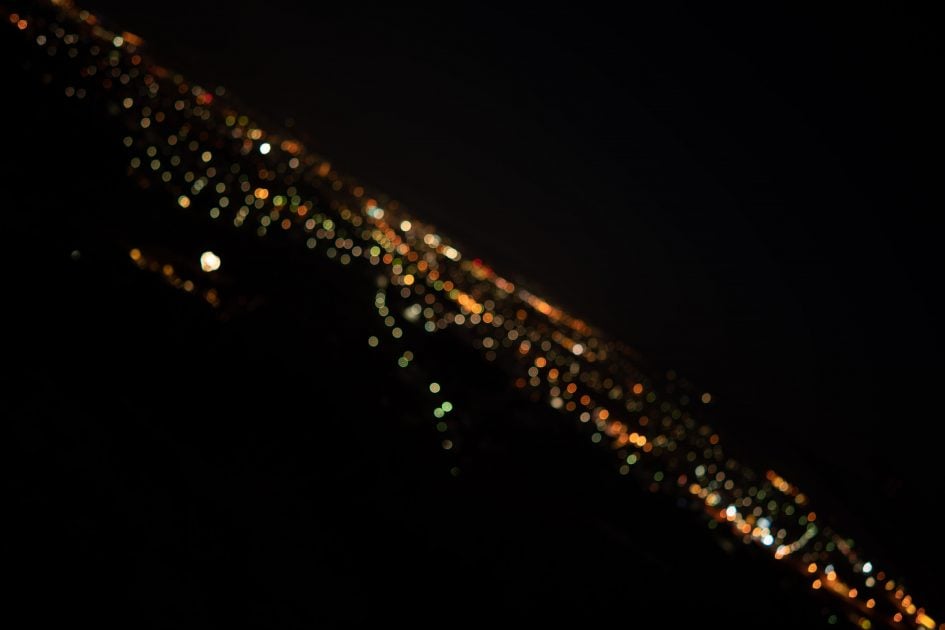
Above: Zeiss 25mm f2.0 Batis at f2.0; click image for 4k version, available as large original at f2.0, f2.8, f4.0, f5.6, f8.0

Above: Zeiss 25mm f2.0 Batis at f2.0; 46% crops from center, APS-C-corner, FF-corner

Above: Sony FE 24mm f1.4 GM at f1.4; 46% crops from center, APS-C-corner, FF-corner; available as large original at f2.0, f2.8, f4.0, f5.6, f8.0

Above: Sigma 24mm f1.4 Art on a 36MP Nikon D810 at f1.4; 50% crops from center, APS-C-corner, FF-corner; available as large original at f2.0, f2.8, f4.0, f5.6

Above: Zeiss 28mm f1.4 Otus on a 36MP Nikon D810 at f1.4; 50% crops from center, APS-C-corner, FF-corner; available as large original at f2.0, f2.8, f4.0, f5.6, f8.0
The Zeiss Batis cannot compete here with its f2.0 focal ratio leading inevitably to a 1/3 smaller Bokeh balls. Plus it suffers from strong Onion rings and outlining.
Let’s see how this analysis of out-of-focus point-light sources translates into Bokeh-performance shooting a book-shelf.
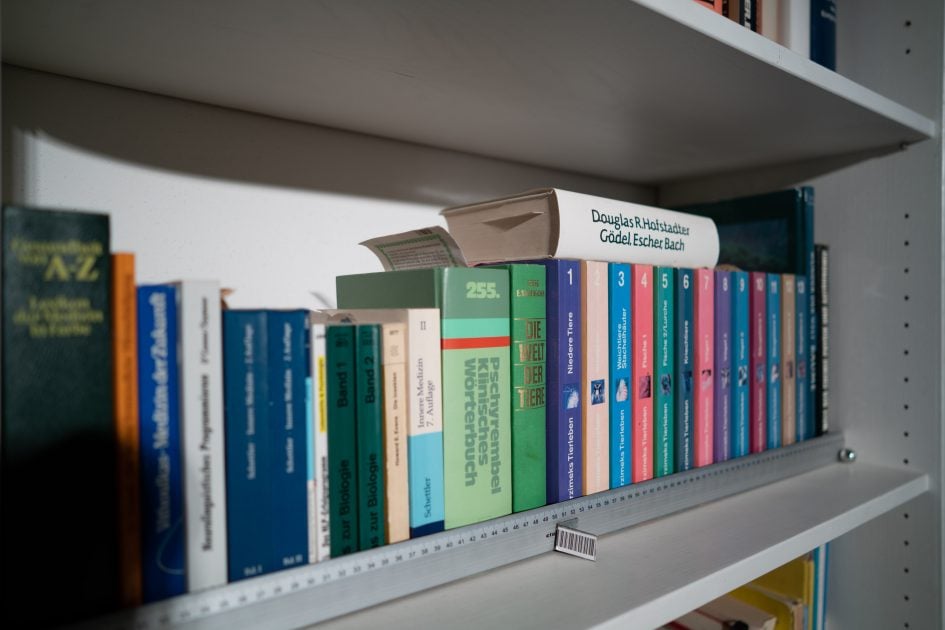
Above: Zeiss 25mm f2.0 Batis at f2.0; click image for 4k version, available as large original at f2.0, f2.8, f4.0, f5.6, f8.0

Above: Zeiss 25mm f2.0 Batis at f2.0; 46% crops from foreground, middle-ground, background

Above: Sony FE 24mm f1.4 GM at f1.4; 46% crops from foreground, middle-ground, background; available as large original at f1.4, f1.7, f2.0, f2.8, f4.0, f5.6

Above: Sigma 24mm f1.4 Art on a 36MP Nikon D810 at f1.4; 50% crops from foreground, middle-ground, background; available as large original at f1.4, f2.0, f2.8, f4.0, f5.6

Above: Zeiss 28mm f1.4 Otus on a 36MP Nikon D810 at f1.4; 50% crops from foreground, middle-ground, background; available as large original at f1.4, f1.8, f2.0, f2.8, f4.0, f5.6, f8.0
The Zeiss Batis produces the least blurred Bokeh although in the background crop it looks better than the overly nervous Sigma Art. The Sony GM produces the best background Bokeh in this comparison with the Zeiss Otus a close second.
Close-up performance
The Zeiss 25mm f2.0 Batis goes down to 1:4.8 magnification which is just a little better than the Sony GM, Sigma Art, or Zeiss Otus. Its performance in close-up shooting is pretty good once you stop down f2.8 or f4.0. The following image was shot at 1:5.4 magnification where the area of sharp focus is just 130 x 195mm. The crops shown below are from the center, 10mm, and 19mm off the center of the sensor respectively:

Above: Zeiss 25mm f2.0 Batis at f2.0, 1:5.4 magnification; 100% crops

Above: Zeiss 25mm f2.0 Batis at f2.8, 1:5.4 magnification; 100% crops

Above: Zeiss 25mm f2.0 Batis at f5.6, 1:5.4 magnification; 100% crops
Flare, ghosting, and sun-stars
Catching a strong light-source shining directly into the lens is always a risky business: it could produce strange colorful ghost-images or reduce contrast considerably through flare and glare. The appearance of flare and ghosting depends on factors like the aperture and the angle of the light hitting the lens. So to judge the proclivity of the Zeiss 25mm f2.0 Batis for these artifacts I went through a series of well calculated shots against a strong light source to provoke glare and ghosting.
The Zeiss 25mm f2.0 Batis is not very prone to flare and ghosting artifacts. The following image at f11 is one of the most obvious examples:
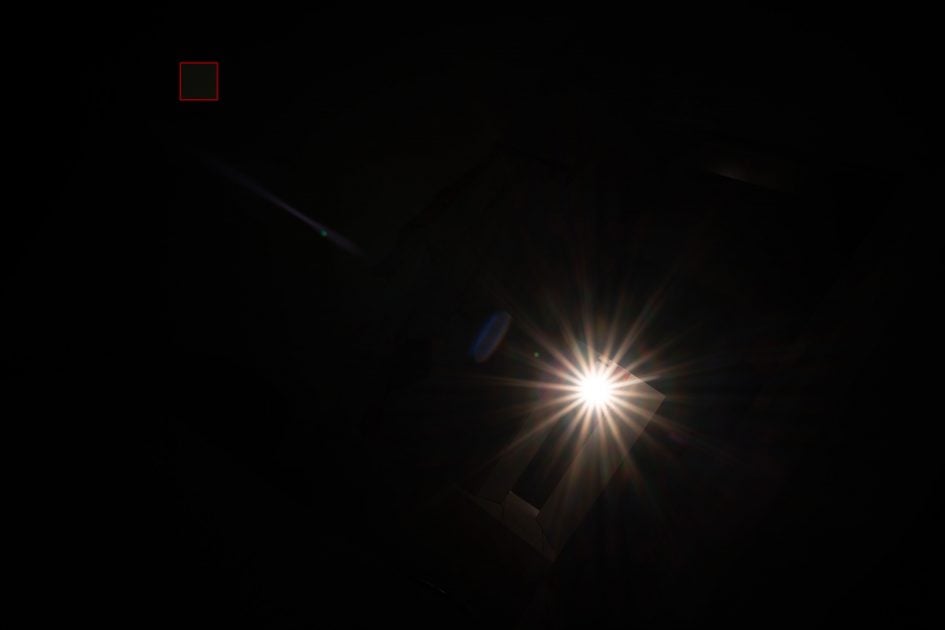
Above: Flare and ghosting. Strong light hitting the Zeiss 25mm f2.0 Batis at f11; click image for 4k version
The little square inset in the upper left of the image shows the respective area with an exposure compensation of +3 EV to make it easier to see which levels of black the lens renders at that point. It clearly shows that the Zeiss 25mm f2.0 Batis renders a very deep black against contra light. In that the Zeiss Batis is similar to the Sony GM. But you better watch out, when the light-source is just outside the corner as it can produce some streaks across the image:
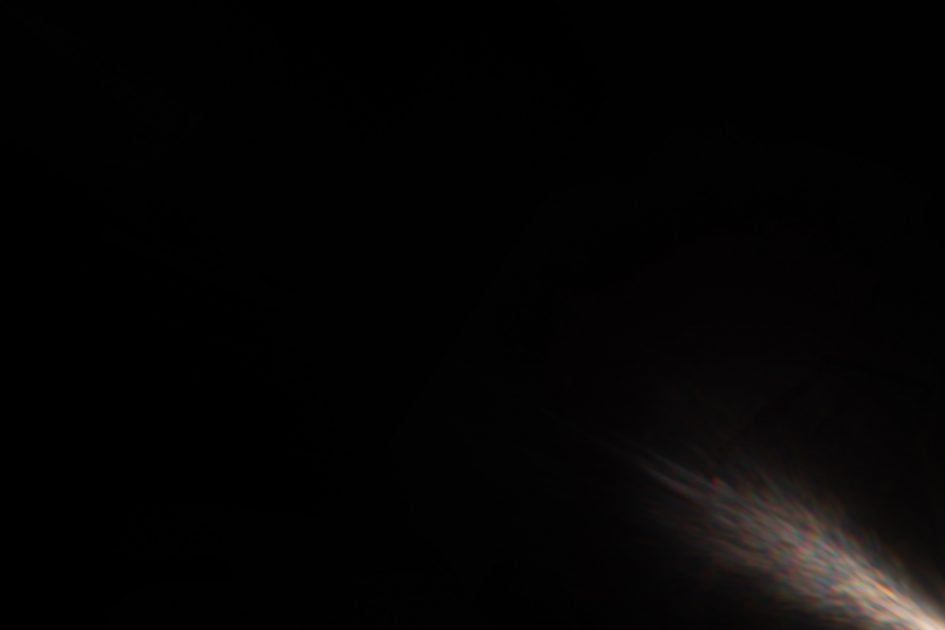
Above: Flare and ghosting. Strong light hitting the Zeiss 25mm f2.0 Batis at f11; click image for 4k version
But except for this effect which only occurs at a very specific angle the Zeiss Batis let’s you shoot confidently under adverse contra-light situations.
Following is an example of sunstars that the Zeiss Batis produces at f5.6:

Above: Sunstars from the Zeiss 25mm f2.0 Batis at f5.6, 100% crop
They don’t get more pronounced at f8.0. For stronger effects you simply need stronger lights.
Next check out my sample images!
Check prices on the Zeiss Batis 25mm f2 at Amazon, B&H, Adorama, or Wex. Alternatively get yourself a copy of my In Camera book or treat me to a coffee! Thanks!




